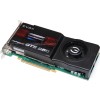- Qualcomm Launches Snapdragon 4 Gen 2 Mobile Platform
- AMD Launches Ryzen PRO 7000 Series Mobile & Desktop Platform
- Intel Launches Sleek Single-Slot Arc Pro A60 Workstation Graphics Card
- NVIDIA Announces Latest Ada Lovelace Additions: GeForce RTX 4060 Ti & RTX 4060
- Maxon Redshift With AMD Radeon GPU Rendering Support Now Available
EVGA GeForce GTS 250 Superclocked

The first mid-range offering of NVIDIA’s GeForce 200 series is here, in the form of the GTS 250. As a follow-up to the company’s 9800 GTX+, we already have a good idea of what to expect. But, various improvements aim to make things interesting, such as a redesigned PCB, smaller form-factor, single PCI-E connector, improved temperatures and refreshed pricing.
Page 4 – Crysis Warhead
As PC enthusiasts, we tend to be drawn to games that offer spectacular graphics… titles that help reaffirm your belief that shelling out lots of cash for that high-end monitor and PC was well worth it. But it’s rare when a game comes along that is so visually-demanding, it’s unable to run fully maxed out on even the highest-end systems on the market. In the case of the original Crysis, it’s easy to see that’s what Crytek was going for.
Funny enough, even though Crysis was released close to a year ago, the game today still has difficulty running at 2560×1600 with full detail settings – and that’s even with overlooking the use of anti-aliasing! Luckily, Warhead is better optimized and will run smoother on almost any GPU, despite looking just as gorgeous as its predecessor, as you can see in the screenshot below.
The game includes four basic profiles to help you adjust the settings based on how good your system is. These include Entry, Mainstream, Gamer and Enthusiast – the latter of which is for the biggest of systems out there, unless you have a sweet graphics card and are only running 1680×1050. We run our tests at the Gamer setting as it’s very demanding on any current GPU and is a proper baseline of the level of detail that hardcore gamers would demand from the game.



Once again, the GTS 250 performed as we expected it to, but neither it nor the 9800 GTX+ could handle the Gamer profile too well in resolutions other than 1680×1050. For higher resolutions, that had to be dropped to Mainstream, as we’ll see below:
|
Graphics Card
|
Best Playable
|
Avg. FPS
|
|
NVIDIA GTX 295 1792MB x 2
|
2560×1600 – Enthusiast, 0xAA
|
42.507 FPS
|
|
NVIDIA GTX 285 1GB x 2
|
2560×1600 – Gamer, 0xAA
|
45.835 FPS
|
|
Zotac GTX 295 1792MB
|
2560×1600 – Gamer, 0xAA
|
37.97 FPS
|
|
EVGA GTX 285 1GB SSC Edition
|
2560×1600 – Mainstream, 0xAA
|
54.551 FPS
|
|
Zotac GTX 285 1GB AMP!
|
2560×1600 – Mainstream, 0xAA
|
53.308 FPS
|
|
NVIDIA GTX 285 1GB
|
2560×1600 – Mainstream, 0xAA
|
51.283 FPS
|
|
Palit GTX 280 1GB
|
2560×1600 – Mainstream, 0xAA
|
46.912 FPS
|
|
XFX GTX 260/216 896MB
|
2560×1600 – Mainstream, 0xAA
|
40.750 FPS
|
|
EVGA GeForce GTS 250 1GB SC
|
2560×1600 – Mainstream, 0xAA
|
35.305 FPS
|
|
ASUS GeForce 9800 GTX+ 512MB
|
2560×1600 – Mainstream, 0xAA
|
34.735 FPS
|
|
NVIDIA GeForce GTS 250 1GB
|
2560×1600 – Mainstream, 0xAA
|
34.327 FPS
|
|
Diamond HD 4870 1GB
|
2560×1600 – Mainstream, 0xAA
|
33.849 FPS
|
|
Palit HD 4870 X2 2GB
|
2560×1600 – Mainstream, 0xAA
|
30.670 FPS
|
|
Sapphire HD 4830 512MB
|
1920×1200 – Mainstream, 0xAA
|
37.051 FPS
|
|
Sapphire HD 4670 512MB
|
1920×1200 – Mainstream, 0xAA
|
25.175 FPS
|
With the Mainstream profile selected, we get slightly better performance than what we saw at 1680×1050 with the Gamer profile. Luckily enough, the Mainstream profile still looks fantastic, and for it to run so well on both the GTS 250 and 9800 GTX+ is great. Cheap gaming doesn’t have to feel cheap, that’s for sure.
Support our efforts! With ad revenue at an all-time low for written websites, we're relying more than ever on reader support to help us continue putting so much effort into this type of content. You can support us by becoming a Patron, or by using our Amazon shopping affiliate links listed through our articles. Thanks for your support!






